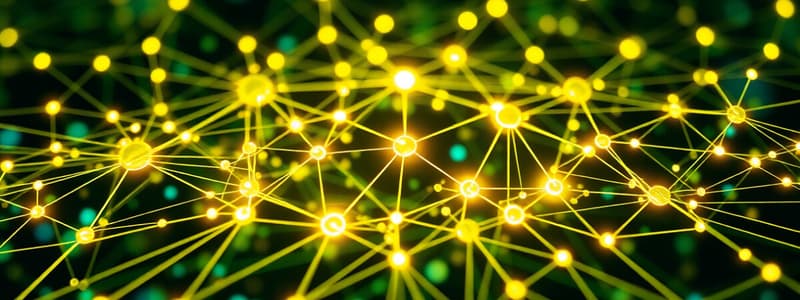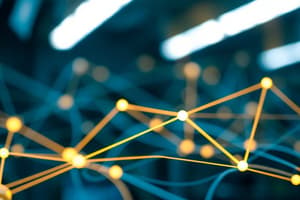Podcast
Questions and Answers
Which network type is most suitable for connecting devices within a single building, such as an office or school?
Which network type is most suitable for connecting devices within a single building, such as an office or school?
- Wide Area Network (WAN)
- Personal Area Network (PAN)
- Metropolitan Area Network (MAN)
- Local Area Network (LAN) (correct)
Which cybersecurity threat involves disguising as a trustworthy entity in an electronic communication to acquire sensitive information?
Which cybersecurity threat involves disguising as a trustworthy entity in an electronic communication to acquire sensitive information?
- Malware
- DoS Attack
- Phishing (correct)
- Ransomware
What is the primary function of a firewall in network security?
What is the primary function of a firewall in network security?
- Managing network bandwidth
- Encrypting network traffic
- Monitoring user activity
- Blocking unauthorized access (correct)
Which digital communication method allows real-time text-based interaction between two or more individuals?
Which digital communication method allows real-time text-based interaction between two or more individuals?
In data management, what is the purpose of a data warehouse?
In data management, what is the purpose of a data warehouse?
Which software development model emphasizes iterative development and collaboration?
Which software development model emphasizes iterative development and collaboration?
What role do version control systems, like Git, play in software development?
What role do version control systems, like Git, play in software development?
Which technology is primarily used to convert analog voice signals into digital data packets for internet transmission?
Which technology is primarily used to convert analog voice signals into digital data packets for internet transmission?
What is the main goal of data governance within an organization?
What is the main goal of data governance within an organization?
Which of the following is a common method used to protect data security by converting it into an unreadable format?
Which of the following is a common method used to protect data security by converting it into an unreadable format?
Which protocol provides authentication and encryption for wireless networks?
Which protocol provides authentication and encryption for wireless networks?
What is the purpose of network segmentation?
What is the purpose of network segmentation?
Which of these technologies allows users to connect to a private network over a public network, such as the internet, securely?
Which of these technologies allows users to connect to a private network over a public network, such as the internet, securely?
Which IT role is primarily responsible for managing and maintaining computer systems, including servers, and ensuring they operate efficiently and securely?
Which IT role is primarily responsible for managing and maintaining computer systems, including servers, and ensuring they operate efficiently and securely?
What is the role of Intrusion Detection and Prevention Systems (IDPS) in cybersecurity?
What is the role of Intrusion Detection and Prevention Systems (IDPS) in cybersecurity?
In the context of email communication, what does SMTP stand for, and what is its primary function?
In the context of email communication, what does SMTP stand for, and what is its primary function?
Which of the following is a key aspect of ensuring data quality?
Which of the following is a key aspect of ensuring data quality?
Which of the following best describes the role of a Security Information and Event Management (SIEM) system?
Which of the following best describes the role of a Security Information and Event Management (SIEM) system?
What are regular network security audits and penetration testing primarily used for?
What are regular network security audits and penetration testing primarily used for?
Which of the following best describes Information Communication Technology (ICT)?
Which of the following best describes Information Communication Technology (ICT)?
Flashcards
Information Communication Technology (ICT)
Information Communication Technology (ICT)
Technologies providing access to information via telecommunications, including the internet, wireless networks, and computers.
Networking
Networking
Connecting two or more computing devices to share data and resources.
Local Area Network (LAN)
Local Area Network (LAN)
Connects devices within a limited area, such as a home or office.
Wide Area Network (WAN)
Wide Area Network (WAN)
Signup and view all the flashcards
Network Topologies
Network Topologies
Signup and view all the flashcards
TCP/IP Model
TCP/IP Model
Signup and view all the flashcards
Cybersecurity
Cybersecurity
Signup and view all the flashcards
Malware
Malware
Signup and view all the flashcards
Phishing
Phishing
Signup and view all the flashcards
Ransomware
Ransomware
Signup and view all the flashcards
Denial-of-Service (DoS) Attacks
Denial-of-Service (DoS) Attacks
Signup and view all the flashcards
Social Engineering
Social Engineering
Signup and view all the flashcards
Digital Communication
Digital Communication
Signup and view all the flashcards
Email
Signup and view all the flashcards
Instant Messaging
Instant Messaging
Signup and view all the flashcards
Data Management
Data Management
Signup and view all the flashcards
Database Management Systems (DBMS)
Database Management Systems (DBMS)
Signup and view all the flashcards
Data Mining
Data Mining
Signup and view all the flashcards
Software Development
Software Development
Signup and view all the flashcards
Information Technology (IT)
Information Technology (IT)
Signup and view all the flashcards
Study Notes
- Information Communication Technology (ICT) encompasses technologies providing information access via telecommunications.
- ICT includes the internet, wireless networks, cell phones, computers, software, middleware, and audio-visual systems.
- ICT focuses on unified communications, integrating telecommunications, computers, enterprise software, storage, and audio-visual systems.
- ICT enhances efficiency and information access across business, education, healthcare, and other sectors.
Networking
- Networking links computing devices for data and resource sharing.
- Networks are categorized by size: Local Area Networks (LANs), Wide Area Networks (WANs), and Metropolitan Area Networks (MANs).
- LANs connect devices in limited areas like homes, schools, or offices.
- WANs span large geographical areas, connecting multiple LANs, often using the internet.
- MANs cover metropolitan areas, larger than LANs but smaller than WANs.
- Network topologies, such as bus, star, ring, and mesh, describe network connection layouts.
- The TCP/IP model is a protocol suite for interconnecting network devices on the internet.
- Key networking devices like routers, switches, hubs, and modems direct and manage network traffic.
Cybersecurity
- Cybersecurity protects computer systems, networks, and digital data from unauthorized access, damage, or theft.
- Common threats include malware (viruses, worms, Trojans), phishing, ransomware, denial-of-service attacks, and social engineering.
- Malware disrupts, damages, or gains unauthorized access to computer systems.
- Phishing fraudulently obtains sensitive information by impersonating trustworthy entities in electronic communications.
- Ransomware encrypts files and demands ransom for restoration.
- Denial-of-service (DoS) attacks flood systems, causing unavailability to legitimate users.
- Social engineering manipulates individuals into revealing confidential information.
- Firewalls, intrusion detection systems, antivirus software, and encryption are important cybersecurity tools.
- Cybersecurity measures include user awareness training, strong password policies, regular software updates, and incident response plans.
Digital Communication
- Digital communication transmits information electronically using digital signals.
- Forms include email, instant messaging, social media, video conferencing, and VoIP (Voice over Internet Protocol).
- Email sends and receives messages electronically via networked computers.
- Instant messaging enables real-time text communication.
- Social media platforms facilitate content creation, sharing, and social networking.
- Video conferencing allows real-time audio-video communication between participants in different locations.
- VoIP converts analog voice signals into digital data packets for internet transmission.
- Key aspects include bandwidth, latency, and protocols like SMTP, HTTP, FTP.
- Quality is measured by clarity, reliability, and security.
Data Management
- Data management includes collecting, storing, organizing, maintaining, and retrieving data.
- Database management systems (DBMS) like MySQL, Oracle, and SQL Server manage structured data.
- Data warehouses store large historical data volumes for analysis and reporting.
- Data mining discovers patterns and insights from large datasets.
- Data governance establishes data asset management policies and procedures.
- Data quality ensures accuracy, completeness, consistency, and timeliness.
- Big data involves extremely large, complex datasets requiring specialized management techniques.
- Data security measures, including access controls and encryption, protect data from unauthorized access and breaches.
Software Development
- Software development creates computer programs/applications through coding, testing, and debugging.
- Software development life cycle (SDLC) models like Waterfall, Agile, and DevOps guide development.
- Programming languages like Python, Java, C++, and JavaScript write software code.
- Integrated Development Environments (IDEs) offer coding, debugging, and testing tools.
- Version control systems (e.g., Git) track source code changes and facilitate collaboration.
- Software testing ensures software meets requirements and is defect-free.
- Software deployment involves installing and configuring software on target environments.
- Software maintenance includes bug fixes, updates, and enhancements.
Introduction of IT
- Information Technology (IT) uses computers, storage, networking, and other devices/processes to create, process, store, secure, and exchange electronic data.
- IT includes hardware, software, data management, and services for essential functions in businesses/organizations.
- IT professionals manage and maintain computer systems, networks, and databases securely and efficiently.
- IT improves efficiency/productivity across business, healthcare, education, government, and other sectors.
- Key IT areas include systems administration, network engineering, database administration, and cybersecurity.
- Emerging technologies like artificial intelligence, cloud computing, and blockchain are transforming IT.
Network Security
- Wireless security protocols like WPA2/3 provide authentication and encryption for wireless networks.
- Virtual Private Networks (VPNs) create secure connections over public networks by encrypting data.
- Network segmentation divides networks into isolated segments to limit security breach impacts.
- Intrusion Detection and Prevention Systems (IDPS) monitor traffic and automate actions against malicious activity.
- Security Information and Event Management (SIEM) systems collect/analyze security logs to identify/respond to incidents.
- Regular network security audits and penetration testing identify vulnerabilities and improve security.
Studying That Suits You
Use AI to generate personalized quizzes and flashcards to suit your learning preferences.




